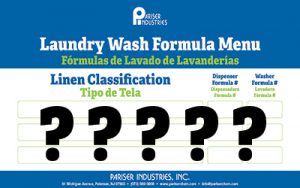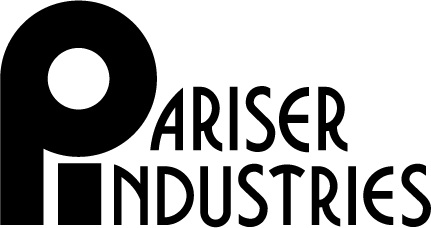Pariser Industries President Scott Pariser was quoted in a recent article posted in American Laundry News regarding factors to consider when creating laundering formulas. There are many aspects to consider when generating appropriate wash formulas. This article dives into these factors and can be read below or found through two links to American Laundry News which can be accessed here:
Part 1 – https://americanlaundrynews.com/articles/creating-effective-wash-formulas-part-1
Part 2 – https://americanlaundrynews.com/articles/creating-effective-wash-formulas-conclusion
“Creating Effective Wash Formulas
Interpretation of laundry industry pie chart key, expert says
CHICAGO — When Graham Skinner was general manager of laundry services at Mission Hospital in Asheville, N.C., he was always on the search for the most effective wash formulas.
“I looked for minimal end-user issues as it relates to stains, etc.,” he says. “These are time-consuming. I would pay more to have reductions in these areas. Cheapest price does not always produce the best outcome.”
In order to create those formulas to produce the best outcomes, Skinner worked side-by-side with his chemicals suppliers—and he looked for specific qualities in those suppliers.
“I want my chemicals supplier to be a good steward of utilities,” he says. “I also want them to be an experienced professional. Tactfully and discreetly share best practices from their experience in the industry and other facilities when they see areas for improvement in my facility.”
Skinner also looked for suppliers who provided documentation of the process for administrative and compliance reasons.
Today, Skinner is on the chemicals side of the industry as a sales manager for U.N.X. Inc. And he knows what laundry and linen service providers are looking for when it comes to creating wash formulas: quality, service and value.
“Many factors are considered when specialists work with customers to design effective wash formulas and processes for all of the different classifications that they handle,” says Steve Tinker, senior vice president of research and development, marketing, for Gurtler Industries Inc.“The basic considerations are soil types (body soils, blood, natural fats/greases, food soils, petroleum oils and greases, and particulate soils, for example), concentrations of the soils (light, medium, heavy, extra heavy), and the types of fabrics (cotton or polyester or blends).”
Kevin Minissian, president and CEO of Norchem Corp., says that while there may be something that can be called the “right” wash formula, that does not necessarily mean there is one right formula.
“For example, the right formulas for one facility may not or will not be the best fit for another,” he says.
David Barbe, director of engineering for U.N.X., agrees, and says there are multiple methods to clean goods.
“One can use traditional high-temp, high-alkalinity baths, or low-temp, enzyme baths,” he says. “Pick your method depending on type of goods, the water quality and temperature available, etc.”
Tinker adds that more specific considerations have to be taken into account, such as type of washing equipment, productivity requirements, and energy and water conservation goals or limits. Other operating conditions, such as the quality of the water and any restrictions on chemistry created by wastewater regulations, also must be considered when a laundry seeks to create the most effective wash formulas for the goods it processes.
LAUNDRY PIE
When it comes to programming wash formulas, the formulator’s interpretation of the established laundry industry pie chart is key, says Scott Pariser, president of Pariser Industries. The “pie” is initially divided into the four equal components of time, temperature, mechanical action and chemistry.
“One must balance all four of these components such that when one item is diminished, one or more of the others must be enhanced,” he says. “Often, operational factors, such as limited production time requirements, and/or the availability of sustained hot water supply, will affect how this chart is manipulated.”
For instance, if a plant can’t provide sustained hot water at required minimums, wash time or mechanical action (through reduced loading weights or water level variation) or chemical dosages, and maybe all three, will need to be enhanced proportionately.
“If one has little mechanical action, something else will have to be increased,” Barbe says. “Those four factors are interrelated. If you have lots of time, you can save on some of the other factors. Or, if you are short of time, you will have to increase the chemicals and/or the temperature.”
Barbe says a good formula is usually the result of starting with reasonable guidelines, titrating the baths for concentration, and then adjusting time, temperature and chemicals to achieve good results.
“Evaluate the results by percentage of stained goods left, brightness, etc.,” he says. “Samples can be sent for lab analysis to test for tensile strength loss, soil levels and many other factors.”
In the end, both the laundry and the chemicals supplier have to consider their customers. Pariser says wash formula construction requires a delicate and thoughtful consideration of the individual laundry and its production requirements, along with local water-in and water-out restrictions, in order to provide the best approach to providing clean, hygienic linens in a cost-effective manner.
“Once we understand the conditions and the operating parameters that the customer wants to meet or is restricted by, then we can design specific wash formulas for every classification in the laundry,” Tinker says. “The best chemistry for the overall conditions is selected. Alkali, water and soil conditioners, detergents, bleaches, fabric softener and/or fabric sanitizer, and sours are all selected for the best possible results.”
FIBERS, SOILS, CHEMISTRY
Two major factors for laundry operators and chemicals suppliers to consider when creating wash formulas are the types of fabrics being processed and the types of soils being removed.
For the type of fabric, Barbe simply recommends reading the label on the goods to be processed.
“Are the goods white or colored? Are they cotton, synthetic or blended?” he queries. “If the laundry isn’t familiar with a type of material, call the manufacturer.”
Then, laundry personnel need to determine what type of soil it is trying to remove.
“Hospital goods? Industrial greases? Food industry? Sunscreen?” Barbe says. “It makes a huge difference in what products and procedures need to be used. If greases and stains aren’t coming out, check your temperatures. Don’t overheat proteins, but try to add heat for greasy stains.”
Once the fabric and soil classifications have been determined, chemistry can be selected.
“It is also important to note that part of what makes a formula particularly right is having top-quality chemistry and the understanding of how that chemistry can adjust to combat any conditions that may affect the wash process,” says Minissian.
“Insist that your chemical rep check the quantities and verify that everything is going in correctly,” Barbe adds. “It’s his job.”
Besides the chemistry, temperature, water levels, time and all other factors must be appropriate for the bath and type of goods being washed.
“One might wash shop rags from the auto shop at 180 degrees with detergent, lots of alkali and some solvent combined in the first bath,” says Barbe. “Yet, a cold flush with a little peroxide is more appropriate for hospital or hospitality goods to flush out certain soils before they get set on the material.”
In the washing operation, usually the pH is on the high end of the alkaline scale, 11.5-12.5, because many soils are acidic in nature and alkalis can react and neutralize or break down these soils so they can be more easily suspended or emulsified by the detergents in the wash liquor, Tinker says.
Also, before the wash formula ends, the fabric has to be at a neutral pH, Minissian says. The fabric needs to be well-rinsed and neutralized to be safe for use—the acidity can result in skin irritations for the end-user.
“Sometimes the inactive alkalinity of the city water can cause a high pH, so it’s imperative to neutralize that, not only to protect for human use, but also protect the fabric from chemical damage,” Minissian says.
Barbe agrees that the pH of a bath is highly important. The pH levels need to be within the proper range.
“For instance, chlorine bleach needs a certain range of pH and temperature to operate properly,” he says. “The wrong range can mean one will get no bleaching, or totally dissolve the goods. The goods also need to end up at a proper pH. Some ironers work better at a little different pH than the linen manufacturer would like the goods to end on.”
Alkalinity levels required for a successful washing will need to be determined, says Scott Pariser, president of Pariser Industries.
“Different bleaches operate better at different temperatures; higher pH requirements may be required for fatty soil saponification and/or acid soil neutralization, while in certain other instances, acidic pH washing for fine washables might be more appropriate,” he says. “So, too, will one need to choose the type and amount of sour and/or an anti-chlor relative to inbound water contaminants such as iron and chlorine.”
Water quality plays a large role in formula construction, he adds.
“Use of water conditioners, location of steam injection (if necessary), formula length and water volumes may all be affected by water hardness, and the aforementioned contaminants found in the inbound water supply,” Pariser says.
Similarly, local ordinances may require tight control over discharge pH levels, a factor that he says will affect alkaline builder usage.”
